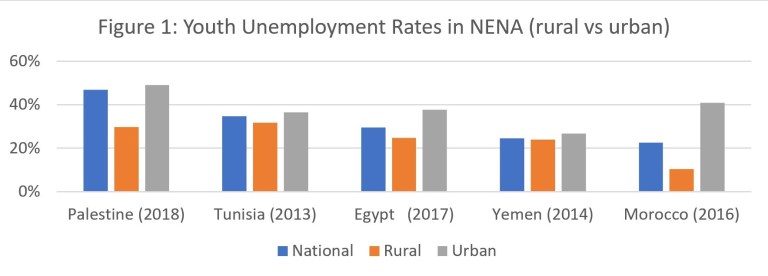High unemployment rates among rural youth are destabilizing the Near East and North Africa region
IFAD Asset Request Portlet
Asset Publisher
High unemployment rates among rural youth are destabilizing the Near East and North Africa region
Estimated reading time: 3 minutes
©IFAD/Susan Beccio
On June 18, 2019, the International Fund for Agricultural Development (IFAD) published its 2019 Rural Development Report (RDR), a seminal publication on creating opportunities for rural youth across the developing world.
The report reached an intuitive, yet often overlooked, conclusion. When economic opportunities in an area are limited, programs and policies aimed at helping rural youth will generally be ineffective. In other words, it is not enough to introduce rural youth policies and programs; rather, these policies and programs must function within constrained local opportunity structures and align with a broader rural development agenda. This conclusion has special relevance for policymakers in the Near East and North Africa (NENA) region; a region that has struggled for over 30 years with the highest rates of youth unemployment in the world.
For decades, NENA governments and the international development community have produced a myriad of policies and programs aimed at tackling the youth employment challenge, without making tangible progress toward improving the economic conditions of young people overall, and of rural youth and young women in particular. Indeed, as the RDR points out, youth policies and programs will only work if they are introduced in tandem with policies that successfully address the broader constraints on rural economic transformation and overall economic development in countries and communities in which young people live.
NENA countries face rigid institutional constraints to private sector development and employment creation. During the 1960s and 1970s, most NENA countries pursued a government-led development model that provided citizens with public jobs, benefits, and services, enabling them to achieve notable gains in human development. However, this model was not sustainable. Beginning in the late 1980s, NENA countries began to liberalize their economies. Yet, the formal private sector that emerged remained over-regulated and mainly benefited those with close ties to the ruling regimes. Combined with high population growth rates, this partial liberalization led the private sector to create fewer jobs than needed, resulting in fewer economic opportunities for the region’s youth. Eventually, the system came under severe strain, resulting in social unrest and uprisings across the region over the past decade.
In NENA countries with available data, youth unemployment rates are higher in urban areas. In Morocco, for example, youth unemployment rates in urban areas are four times higher than in rural areas (Figure 1). The RDR explains this phenomenon in the context of the rural transformation process. When structural transformations in the non-agriculture economy stall, they block the ability of young people to transition out of agriculture – a sector into which they can more easily be absorbed into the labor force – into other sectors such as manufacturing and services. The result is higher rates of underemployment in rural areas and higher rates of unemployment in urban areas.

Sources: International Labour Organization Database (ILOstat), accessed June 30, 2018,; High Commission of Planning (HCP) database, accessed August 28, 2018
The lackluster structural transformation process has short-circuited the rural transformation process and dampened the incentives to increase agricultural productivity. As a result, the NENA region produces insufficient food for domestic consumption. The Western Asia / Northern Africa region is among the highest net importers of food in the world. In addition, NENA is the most water-stressed region in the world, with renewable internal water resources of only 550 cubic meters per capita – one seventh the amount of water resources in the next most-stressed region, Sub-Saharan Africa. These factors have contributed to food insecurity and social instability and have contributed to frustration, radicalization, and social unrest.
In order to address the chronically high rates of unemployment and joblessness among the region’s youth, NENA governments must address the underlying causes behind the lack of economic opportunity in their countries. Ideally, this would involve fundamentally restructuring the social contract to provide a balance between social services and truly liberal economic policies (not the perverted crony-capitalist version that has emerged throughout the region). At the very least, policymakers should carve out a well-defined space within the private sectors of urban and rural areas where the specific industries and economic activities can grow and thrive without the burden of over-regulation or interference from those with privileged access.
That said, the 2019 RDR points out that policymakers should recognize the special circumstances of rural youth. In addition to weak gains in productivity resulting from the weak structural and rural transformation processes, rural youth face multiple, overlapping layers of exclusion, including limited access to drivers of productivity gains, such as education and skills training, and fewer opportunities to connect physically and virtually to markets, information and social networks. These two factors limit the ability of rural youth to decide their futures. The RDR thus concludes that youth-centered rural transformation policies and investments must be based on increasing the productivity, connectivity and agency of rural youth.
This post was first published at Brookings
